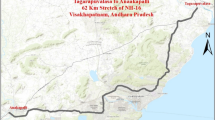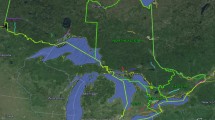Abstract
The objective of this study is to evaluate a set of variables that contribute to the degree of injury severity sustained in traffic crashes of Korean expressways. To this end, we examined three statistical models — ordered probit, ordered logit, and multinomial logit — to determine the most appropriate model for crash records that were collected from the entire network of Korean expressways in 2008. Interpretation of the estimated coefficients in the selected model provides relative risks of significant influential factors for injury severity. The findings from this study are expected to help transportation planners and engineers understand which risk factors contribute more to the injury severity in Korean expressways such that they can efficiently allocate resources and effectively implement safety countermeasures.
Similar content being viewed by others
References
Abdel-Aty, M. (2003). “Analysis of driver injury severity levels at multiple locations using ordered probit models.” Journal of Safety Research, Vol. 34, No. 5, pp. 597–603.
Abdel-Aty, M. and Abdelwahab, H. (2004). “Modeling rear-end collisions including the role of driver’s visibility and light truck vehicles using a nested logit structure” Accident Analysis & Prevention, Vol. 36, No. 3, pp. 447–456.
Borooah, V. K. (2001). Logit and probit: Ordered and multinomial models. Sage Publications, London.
Eluru, N., Bhat, C. R., and Hensher, D. A. (2008). “A mixed generalized ordered response model for examining pedestrian and bicyclist injury severity level in traffic crashes.” Accident Analysis and Prevention, Vol. 40, No. 3, pp. 1033–1054.
Jang, K., Park, S. H., Chung, S., and Song, K. (2010). “Influential factors on level of injury in pedestrian crashes: Applications of ordered probit model with robust standard errors.” 89th Annual Meeting of the Transportation Research Board, Washington, D.C.
Klop, J. (1998). “Factors influencing bicycle crash severity on two-lane undivided roadways in North Carolina.” 78th Annual Meeting of the Transportation Research Board, Washington, D.C.
Kockelman, K. M. and Kweon, Y. J. (2002). “Driver injury severity: An application of ordered probit models.” Accident Analysis and Prevention, Vol. 34, No. 3, pp. 313–321.
Korea Transport Database (2011). The number of traffic accidents and casualties, http://www.ktdb.go.kr/.
Lee, H. R., Kim, K. J., and Son S. N. (2011). “A study on the factor analysis by grade for highway traffic accident.” Korean Society of Road Engineers, Vol. 13, No. 3, pp. 157–165.
Lee, D. M., Kim, E. C., Sung, N. M., and Kim, D. H. (2008). “Development of severity model for rural unsignalized intersecton crashes.” Korean Society of Road Engineers, Vol. 10, No. 3, pp. 47–56.
Lee, S. I., Lee, H. S., and Won, J. M. (2007). “An analysis of the vehicle characteristics to effect on highway traffic accidents — Focussing on tire accidents.” Korean Society of Civil Engineers, Vol. 27, No. 4, pp. 405–412.
McKelvey, R. D. and Zavoina, W. (1975). “A statistical model for the analysis of ordinal level dependent variables.” Journal of Mathematical Sociology, Vol. 4, No. 1, pp. 103–120.
O’Donnell, C. and Connor, D. (1996). “Predicting the severity of motor vehicle accident injuries using models of ordered multiple choices.” Accident Analysis and Prevention, Vol. 28, No. 6, pp. 739–753.
Oh, J. T. (2006). “Development of severity models for vehicle accident injuries for signalized intersections in rural areas.” KSCE Journal of Civil Engineering, Vol. 10, No. 3, pp. 219–255.
Oh, J. T., Washington, S., and Lee, D. M. (2010). “Property damage crash equivalency factors to solve crash frequency-severity dilemma: Case study on South Korean rural roads.” Transportation Research Record: Journal of the Transportation Research Board, Vol. 2148, pp. 83–92.
Park, J. T., Kim, Y. S., and Lee, S. B. (2009). “The analysis of older driver’s traffic accident characteristic at express-way using Logit model.” Korean Society of Road Engineers, Vol. 11 No. 4, pp. 1–7.
Park, J. S., Park, G. S., Kim, T. Y., and Park, B. H. (2008). “Characteristics and severity of side right-angle collisions at signalized intersections.” Korean Society of Road Engineers, Vol. 10,No. 4, pp. 199–211.
Ryu, S. O. and Park, B. H. (2006). “Multivariate regression analysis between geometric structure and traffic accident in expressway intersections.” Journal of the Institute of Constructional Technology, Vol. 25, No. 1, pp. 1–23.
Shim, K. B. (2009). “The determination of risk group and severity by traffic accidents types — Focusing on Seoul City -.” Korean Society of Road Engineers, Vol. 11, No. 2, pp. 195–203.
Singleton, M., Qin, H., and Luan, J. (2004). “Factors associated with higher level of injury severity in occupants of motor vehicles that were severely damaged in traffic crashes in Kentucky, 2000–2001.” Traffic Injury Prevention, Vol. 5, pp. 144–150.
Sohn, S. Y. and Shin, H. W. (2010). “Pattern recognition for road traffic accident severity in Korea.” Ergonomics, Vol. 44, No. 1, pp. 107–117.
Spiegel, M. R. and Stephens, L. J. (1982). Schaum’s outline of theory and problems of statistics and econometrics. McGraw-Hill, London.
Statistics Korea (2010). Annual report on the cause of death statistics (2009), Statistics Korea, Korea.
Tarko, A. P., Bar-Gera, H., Thomaz, J., and Issariyanukula, A. (2010). “Model-based application of abbreviated injury scale to policereported crash injuries.” Transportation Research Record: Journal of the Transportation Research Board, Vol. 2148, pp. 59–68.
Washington, S. P., Karlaftis, M. G., and Mannering, F. L. (2003). Statistical and econometric methods for transportation data analysis, Chapman & Hall/CRC, Boca Raton, Florida.
Author information
Authors and Affiliations
Corresponding author
Rights and permissions
About this article
Cite this article
Park, S., Jang, K., Park, S.H. et al. Analysis of injury severity in traffic crashes: A case study of Korean expressways. KSCE J Civ Eng 16, 1280–1288 (2012). https://doi.org/10.1007/s12205-012-1527-3
Received:
Revised:
Accepted:
Published:
Issue Date:
DOI: https://doi.org/10.1007/s12205-012-1527-3




